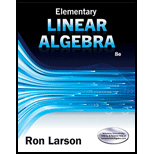
Verifying Inequalities In Exercises
Want to see the full answer?
Check out a sample textbook solution
Chapter 5 Solutions
Elementary Linear Algebra (MindTap Course List)
- Prove that the usual toplogy is firast countble or hot and second countble. ①let cofinte toplogy onx show that Sivast countble or hot and second firast. 3) let (x,d) be matricspace show that is first and second countble. 6 Show that Indiscret toplogy is firstand Second op countble or not.arrow_forwarda) Find the scalars p, q, r, s, k1, and k2. b) Is there a different linearly independent eigenvector associated to either k1 or k2? If yes,find it. If no, briefly explain.arrow_forwardThis box plot represents the score out of 90 received by students on a driver's education exam. 75% of the students passed the exam. What is the minimum score needed to pass the exam? Submitting x and Whickers Graph Low 62, C 62 66 70 74 78 82 86 90 Driver's education exam score (out of 90)arrow_forward
- How many different rectangles can be made whose side lengths, in centimeters, are counting numbers and whose are is 1,159 square centimeters? Draw and label all possible rectangles.arrow_forwardCo Given show that Solution Take home Су-15 1994 +19 09/2 4 =a log суто - 1092 ж = a-1 2+1+8 AI | SHOT ON S4 INFINIX CAMERAarrow_forwarda Question 7. If det d e f ghi V3 = 2. Find det -1 2 Question 8. Let A = 1 4 5 0 3 2. 1 Find adj (A) 2 Find det (A) 3 Find A-1 2g 2h 2i -e-f -d 273 2a 2b 2carrow_forward
- Question 1. Solve the system - x1 x2 + 3x3 + 2x4 -x1 + x22x3 + x4 2x12x2+7x3+7x4 Question 2. Consider the system = 1 =-2 = 1 3x1 - x2 + ax3 = 1 x1 + 3x2 + 2x3 x12x2+2x3 = -b = 4 1 For what values of a, b will the system be inconsistent? 2 For what values of a, b will the system have only one solution? For what values of a, b will the saystem have infinitely many solutions?arrow_forwardQuestion 5. Let A, B, C ben x n-matrices, S is nonsigular. If A = S-1 BS, show that det (A) = det (B) Question 6. For what values of k is the matrix A = (2- k -1 -1 2) singular? karrow_forward1 4 5 Question 3. Find A-1 (if exists), where A = -3 -1 -2 2 3 4 Question 4. State 4 equivalent conditions for a matrix A to be nonsingulararrow_forward
- How long is a guy wire reaching from the top of a 15-foot pole to a point on the ground 9-feet from the pole? Question content area bottom Part 1 The guy wire is exactly feet long. (Type an exact answer, using radicals as needed.) Part 2 The guy wire is approximatelyfeet long. (Round to the nearest thousandth.)arrow_forwardQuestion 6 Not yet answered Marked out of 5.00 Flag question = If (4,6,-11) and (-12,-16,4), = Compute the cross product vx w karrow_forwardConsider the following vector field v^-> (x,y): v^->(x,y)=2yi−xj What is the magnitude of the vector v⃗ located in point (13,9)? [Provide your answer as an integer number (no fraction). For a decimal number, round your answer to 2 decimal places]arrow_forward
- Algebra & Trigonometry with Analytic GeometryAlgebraISBN:9781133382119Author:SwokowskiPublisher:Cengage
 Elementary Linear Algebra (MindTap Course List)AlgebraISBN:9781305658004Author:Ron LarsonPublisher:Cengage Learning
Elementary Linear Algebra (MindTap Course List)AlgebraISBN:9781305658004Author:Ron LarsonPublisher:Cengage Learning Trigonometry (MindTap Course List)TrigonometryISBN:9781337278461Author:Ron LarsonPublisher:Cengage Learning
Trigonometry (MindTap Course List)TrigonometryISBN:9781337278461Author:Ron LarsonPublisher:Cengage Learning  Algebra and Trigonometry (MindTap Course List)AlgebraISBN:9781305071742Author:James Stewart, Lothar Redlin, Saleem WatsonPublisher:Cengage Learning
Algebra and Trigonometry (MindTap Course List)AlgebraISBN:9781305071742Author:James Stewart, Lothar Redlin, Saleem WatsonPublisher:Cengage Learning



